Memories of Master Asai
It has been five years since Master Asai passed away. It took me a while to recover from the loss and I am still in the process, but I am now able to sort through collections of interviews about Master Asai. Thank you for your patience. Keiko Asai
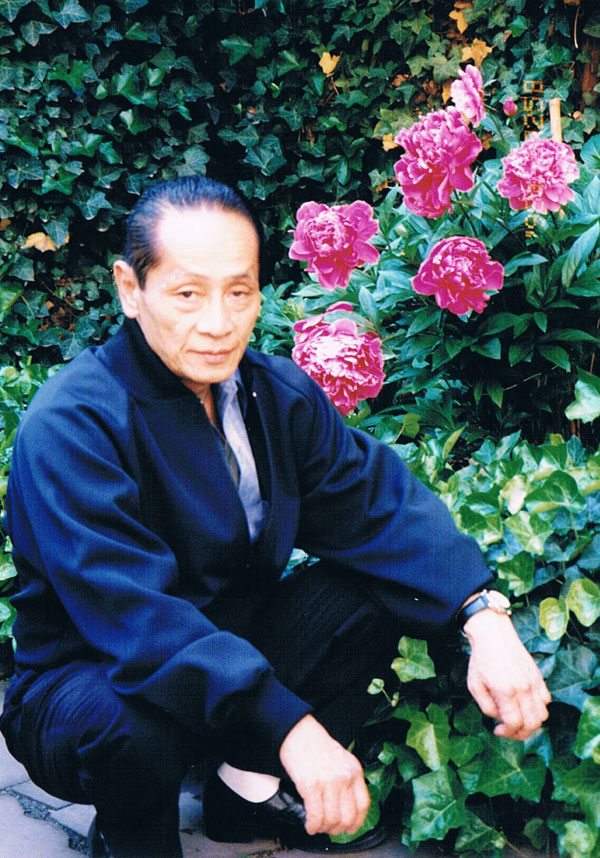
Chen Hsin-koei
Head of IJKA Technical Office
■January 27th, 2007 12:00 Interview at Taoyuan Airport, Taiwan
I started learning karate in 1963, when I was 6 years old. I was still very small.
My father taught my older brother and I karate. My interest in karate started out because of my father, aunt and Master Asai, but the more I learned the stronger my passion for it became.
At first I was learning White Crane Fist, which uses a lot of hand techniques, but my father told me to switch to karate because it had richer variety of defense and offense techniques and because he saw it as more dynamic. This is how my karate journey started. It has been 43 years (47 years as of 2011) since then.
I ended up choosing karate, the one with numerous forms and techniques, out of all martial arts. I came to believe, through my years of practice and teaching, that karate gives you confidence. This is the reason why I use the expression: “Cultivate both health and confidence” when I recruit new students.
After years of training under Master Asai, physically speaking I was able to reach what we call the “Da kai yan jie” state, which means eyes wide open.
Because I am his family member, I saw Master Asai’s never-ending commitment. I also witnessed how he never stopped training and always pushed himself to go further.
One event that left a strong impression in my memory was the day I was visiting Japan and it was snowing. It doesn’t snow in Taiwan. I woke up early in the morning and heard the sound of someone hitting a straw bale. Snow was hitting the windows hard. In the midst of the heavy snowfall, Master Asai was practicing Tsuki with the rice straw bale. When I got outside and approached him I realized he was naked and the snow was falling onto his steaming body. Another time when I visited Master Asai in Yokohama, one of the days was rainy, which made me think that there would be no practice. Of course with Master Asai, it doesn’t work like that; we practiced in the rain.
Also when Master came to Taiwan a few years ago for the Taiwan national training camp, he rode with me in my car. Perhaps the car was too small for him. In the back mirror I saw him stretching one leg straight up, with the toe touching the roof of the car. He kept the position for a long time and after a while switched to the other leg. I had watched his karate kicks closely many times and knew how flexible he was. I thought in the car maybe he became this flexible because he was always attentive to his body, even riding in a car. At the same time, I felt bad that the car was so small. When I drove him an earlier time, I apologized to him about the size of the car. He said “as long as it takes us to where we need to go, I don’t care about the rest. I have been driven in numerous fancy cars but I don’t want a fancy big car. I like your car.” At that point I promised myself to buy a big car so that Master can ride with me again the next time he comes.
Now I have such a car, but he is not with me. (Mr.Chen wipes his tears.) I sometimes feel that I can see him in the back mirror but all I can do is to try my hardest to practice the new technique he had left with me, and pass it on to the next generation.
When I tried out for a dan promotion test in Japan, I was asked to stand inside a circle 1m in diameter. Within the circle I had to defend against three instructors taking turns. (One foreigner was thrown out and hit the wall.) “If you run away from inside the circle, the three instructors will attack you all at once,” the judge said. Everyone waiting in line for their test all canceled.
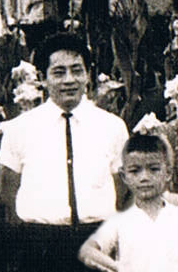
Picture: The first time Master Asai taught me karate. (6 years old)
Mr. Bruno Koller from Switzerland
“押忍(Osu)” (November, 2006)
「押忍」
“Osu” is a compassionate greeting, a rule, that connects students and teachers, and is based on duty and responsibility. Through “Osu,”
students and teachers are able to build strong relationships. “Osu” is also a word that anyone who practices karate will have a close association with,
and the pioneering spirit hidden in this word cannot be dismissed.
I would like to take this opportunity to thank the teachers who have taught me karate.
I value the two-year training under Sato Sensei higher than the tallest mountain of Japan, Mt. Fuji.
Hiroshi Shoji SenseiI was able to meet Shoji Sensei through Sato Sensei. He always called me “Hen na gaijin (strange foreigner.)”
Tetsuhiko Asai SenseiThe time I spent working with Master Asai and learning traditional karate from him has become a strong and valuable asset in my life. His forms of karate are wide-ranging and are suited to everyone. Master Asai is a genius karateka and teacher and everyone will always remember.
When Master Asai came to Switzerland, he said to me that he “ate a 600g steak in Brazil.” So I said to him “you ate a whole cow” but we knew he ate a 600g steak and that he was only trying to make us laugh.

|
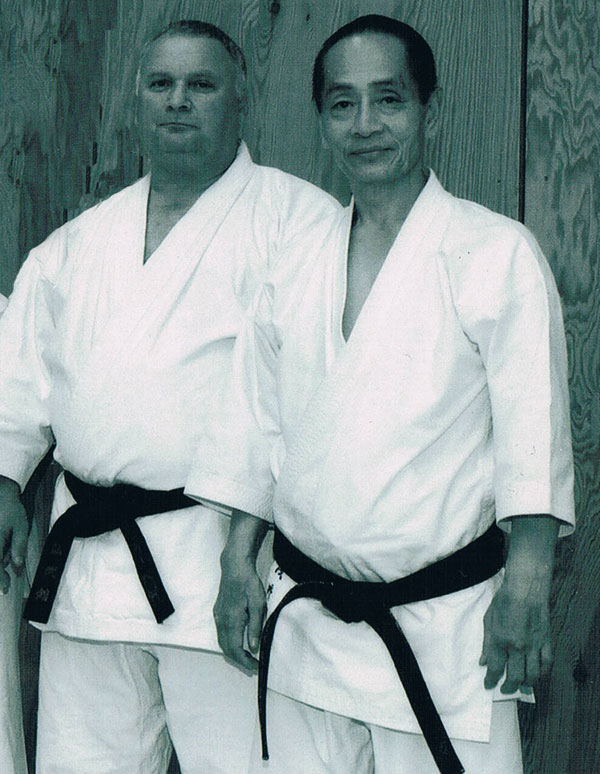
|
| スキーのインストラクターだった頃、空手を習い始めた。 |
Interview at the Main Dojo in Taipei, Taiwan (September 25th, 2007)
It is my first time to come to Taiwan, and it’s been great. I am excited to practice Asai Karate, and everyone here is very nice.
I am very pleased that I was able to learn techniques directly from Chan Sensei. I would love to come back to Taiwan. People here are so nice.
Edward Fujiwara from Hawaii
For the last 42 years it hasn’t mattered which country we were in, every year on Master Asai’s birthday (June 7th), Christmas, and New Year’s Day, Mr. Fujiwara gave us a call from Hawaii.He continues even now with Master Asai gone. At Mr. Fujiwara’s house, there are many mementos of Master Asai, all beautifully lined up and displayed, including Master Asai’s last cigarette butt stored in a glass case, all resembling a mini memorial museum of Master Asai.
At Master Asai Memorial Camp in Hawaii (June 1st, 2007)
With God’s help, I was able to meet Master Asai. The first time I met him was when I was practicing karate at a dojo.I was taking a break after some hard training, when he approached me. He introduced himself and told me that from next time I should relax more when I practice, and not be so tense. That was our first encounter. I am now 62 years old, and I have been doing karate for 42 years (47 years as of 2012) and Master Asai has always been in my heart.
I have many memories of Master Asai. When I developed diabetes and told him that I could not continue karate, he wouldn’t accept it. I explained to him numerous times but he didn’t listen.
After awhile I had enough and yelled at him saying “Fine. I am throwing my medicine away and going to practice karate. If I die, it will be your fault!” I continued with the hard training all the while angry with him, but soon enough my diabetes and high blood pressure were gone. He had been very patient with me, and very kind. For forty years he never complained, and taught me many things. There are things I didn’t understand back then, but now I do. I practice karate recalling what he had said. I pray to God, who is most important to me, everyday for my family and Master Asai, and to protect my family and Mrs. Asai.
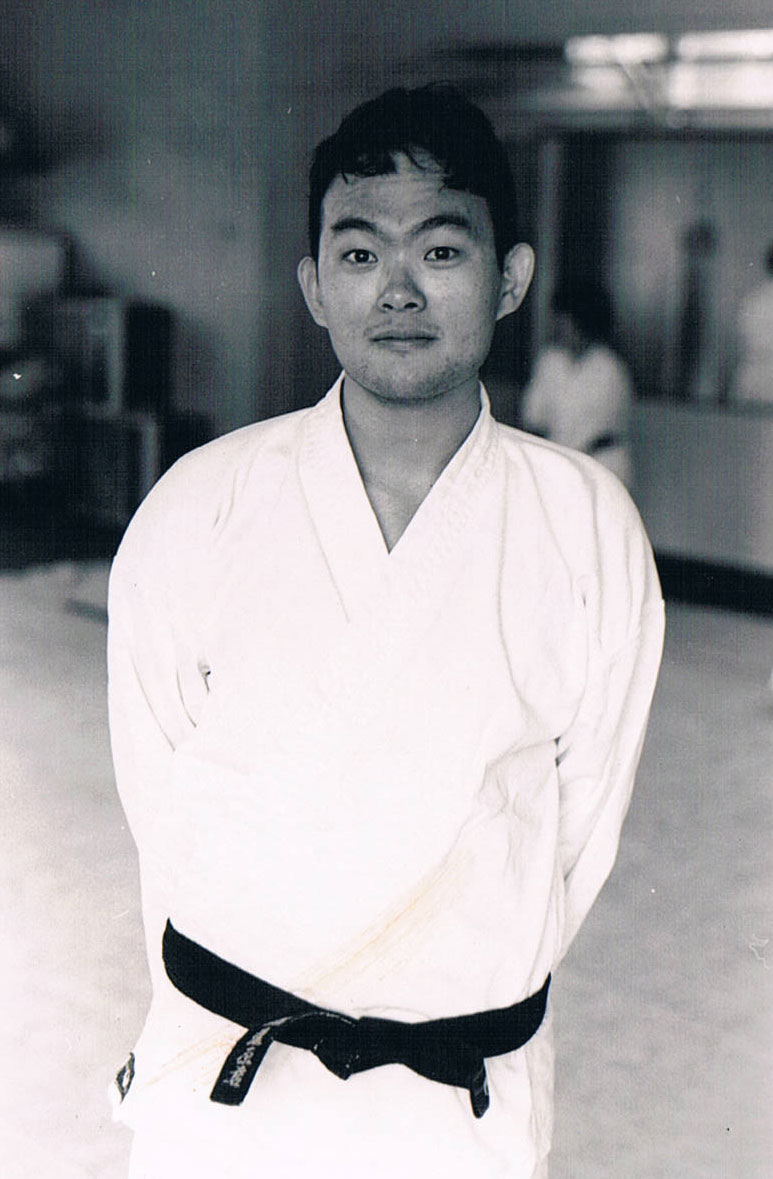
|

|

|
|
21才大学1年生 |
浅井先生とのツーショット | 浅井先生の得意技 |
Chen Hung-tsung Chief Instructor
Interview 2007.1.26
I tried sumo, acquired 3-dan in judo as well as in kendo, and practiced the Crane Fist for about 60 years. Out of the many types of martial arts I have practiced, I find karate is the best. I was in my 30s when I first read about karate in a book.When I was 35, my sister brought Master Asai and karate to Taiwan.
The master of the Crane Fist, 林元龍Sensei, was so deeply impressed by just watching Master Asai’s kicks that he said karate was the best of all martial arts, and especially “Asai’s karate” was the most logical and would be hailed all around the globe. That was 50 years ago, and now his words came true.
What left me the deepest impression was when he did a demonstration with me. He told me to attack him with tsuki (punches) so I tried, but I wasn’t even close. A big roar arose from the crowd of people watching the demonstration, who were all familiar with martial arts themselves. I turned back thinking they were angry, but in fact it was a sound of pure astonishment. They underestimated Master Asai and didn’t expect much from “a young punk,” who was still in his late 20s at the time.
Master Asai is truly a genius of combat sports. When I still had not completed my 7-joint whip technique even after 10 years of practice, Master Asai mastered it in 2 weeks, surprising everyone. He also quickly mastered various other techniques.
Even though he is still “guiding and instructing” the world’s karate enthusiasts as a shihan on Youtube, I sincerely wish he could have lived for another 10 years. In another 10 years, he could have changed the world’s karate. Some say Asai karate is too difficult - I say that is why we need to practice hard, and because they don’t practice, Asai karate remains too difficult.
It is really a shame that he could not stay with us for another 10 years. Now what we have left is us, the students, and it is our responsibility to in our best effort carry out his teachings.
An interview with the new member of the IJKA Instructors Committee, Mr. Toshiyuki Kidokoro (6-dan)
Master Asai was the chief judge and sitting in the middle of the table at my Shodan Tokui kata ('specialty' form) examination, when I was 20 years old. He would only glance up once in a while to see my face, but mostly he was looking down to watch my leg movements. It left a strong impression that he only looked up after a while. At our level the only chance to see Master Asai was once or twice a year at a tournament where he would judge the final match. When I later asked him why he only paid attention to the legs, he replied that the leg movements told everything about the level of the person. He was also developing leg waza (technique) at that time.
Also at that time, karate instructors had their own style of judging tournaments.
Since Master Asai's was a very unique one, many of his junior instructors tried coping it for fun.
I still remember Master Asai explaining to me about 2 or 3 years ago that the reason why he gestured scores with his palm up was not out of a simple habit but it represented respect for the contender for the hard earned point in the match. He told me every judge should do the same, as it had significance.
When I was going to the main dojo, several instructors told me about Master Asai's karate.
They said what was so amazing about Master Asai's karate was, as unbelievable as it sounds, he was able to go under and hop atop the knee of a kicking leg. They also mentioned about his Whip fist technique, which I was still unsure about at the time, saying that it could easily crack 3 to 4 layers of wood board.
So in such a way, Master Asai's every move became a legend.
Mr. Chen Hung-tsung says if Master Asai had lived for another 10 years, only 10 more years, he could have brought a change in karate in Japan and the rest of the world.
It is true that Master Asai's karate is characterized by the use of body joints, but what I realized recently was what he showed me in Taiwan every time he came visited: the timing of how he so smoothly approached the opponent during kumite (sparring) was so refined it was impossible for others to copy. From that subtle timing, many different waza were born.
I think it was possible for Master Asai because he was never thinking of retreat.
Mr. Kenneth Funakoshi
■July, 2007 Los Angeles
When Asai Sensei came to Hawaii in 1965, I was 22 years old and in Air Force in Hawaii. When he left Hawaii he appointed me as the acting chief instructor of IJKA pacific region area.
Asai Sensei and I were very close. For four to five years I trained every night under him. We used to do many karate demonstrations at Japanese teahouses and at tournaments and so we practiced a lot at the dojo afterhours.
I was the grand championship at karate tournaments. I took first place kata for five years straight, and first place at kumite for three years straight, and second place for two years. We learned from Asai Sensei that spirit is the main thing in karate.
In 1984, I stayed at Asai Sensei’s house in Japan for two weeks. I was planning on staying at a hotel, but Sensei’s wife insisted I stay with them. We trained from six o’clock in the morning, and Mrs. Asai cooked the breakfast. Then we would go down to the main dojo and train at the instructors’ class, and go back to his house where Mrs. Asai would be waiting with dinner. I remember everyday she made us breakfast and dinner. I remember these two weeks very well. I felt honored and privileged to be invited to stay at Asai Sensei’s house when I was in Japan. Those were very good times.
I only have good memories of Asai Sensei. He was not only a kumite and kata master and the prestigious kumite champion of karate, but most importantly he was a good person and a fine human being. I learned a lot about being a fine person and character from him and I am teaching everyday what I learned from Asai Sensei, about not only good karate techniques but also perfecting a character and being a good human being. Most people just like to look for former champions of kumite and kata to learn karate but they don’t realize that is only part of it. You need to be a good human being besides a karate champion. Asai Sensei had both those qualities, and I was very fortunate to be able to train under him for almost five years.
He used to call me his brother whenever we were with other people and did things together, and I think it’s an honor for me to be mentioned that I was his brother.
I think a part of my success is training under him, and what I learned from him - not only developing your character but also the advanced techniques Asai Sensei used to teach. I found that he was a very unique person because he had advanced techniques nobody else could teach. Everyone in karate Shotokan talks about Asai Sensei’s fast techniques and advanced type of techniques.
Actually I never planned on becoming a karate instructor but because of my tournament record after Asai Sensei went back to Japan he appointed me as chief instructor. I quit my fulltime job as office manager and became a fulltime karate instructor. From then I kept on teaching and teaching, and things started to develop. Some of my students moved to Seattle, Washington and parts of California, and they requested me I visit them to teach seminars and give examinations. From there, some people called me to go to Poland, England and Russia… and things kept on growing. My organization is just growing every year and I have world tournaments now every year now too. I had my last five world Tournaments in Las Vegas, this year it will be in England, and in a couple of years we will probably have it in South Africa.
Some of my good memories I have of Asai Sensei - I have many many stories to tell, and when I teach whenever one comes to mind I tell stories of my sensei. When we used to give exhibitions at Japanese teahouses, there was a time when Asai Sensei was supposed to do a kick from the floor. When somebody attacked him he dropped to the floor and did something. We couldn’t figure out what he did because we just saw a blur of a kick. Later we found out that he thought his first kick missed so he threw a second kick. We couldn’t figure it out what happened because it was done so fast.
Another time we were waiting for the chance to get onto the stage in an exhibition, and Asai Sensei was squatting down. I came behind Asai Sensei and put my hands on his shoulder and said “Sensei, what are you going to do now? You cannot move, I attack you from behind.” You’d see later he was kicking right up to my face like this from the squatting position. Nobody can do that - squatting down and try to kick like that with somebody behind you, but he did it.
So we have many many things to tell about many things he could do. Before I met Asai Sensei in 1962, Kanazawa Sensei said “In Japan there was a man so fast. With kumite or when you fight him or attack him, he disappears! You look left and right but he’s gone - he is behind you giving a punch.” We found out later on when Asai Sensei came we asked him. He told us at a tournament when somebody attacked him with a front kick, Asai Sensei went underneath the front kick and came up behind him and punched the guy in the back. Nakayama Sensei was the judged and he couldn’t see what happened but with instinct he gave Asai Sensei a Ippon for the punch and he won the match.
Of course there are a lot of stories of Asai Sensei: jumping in the air and doing flying side kicks and all that. There are many photos of Sensei doing jump kicks in the air, and again, we are very fortunate to have someone so talented like him to teach us for almost five years. Many people who train Shotokan karate like to hear stories the of the past and past champions from Japan, and whenever I go out to teach I talk about Asai Sensei and his amazing techniques and the feats that he did. Not only doing demonstrations but also when he was actually competing in tournaments.
Mr. Kenneth Funakoshi’s background
- 1948 Start Judo at age 10
- 1954 Become football player at age 16
- 1956 Start Kempo at age 18
- 1959 Join US Air Force, teach Kempo at age 21 (picture 1)
- 1960 Teach Kempo at age 22 (Picture 2)
- 1964-1968 Become Grand Champion at Karate Association of Hawaii Tournament (picture 3)
- 1969 Get appointed as Chief Instructor of Karate Association of Hawaii
- 2007 Appear on cover page of Italian karate magazine (picture 4)
- Present Shuseki Shihan at Funakoshi Shotokan Karate Association, California, USA
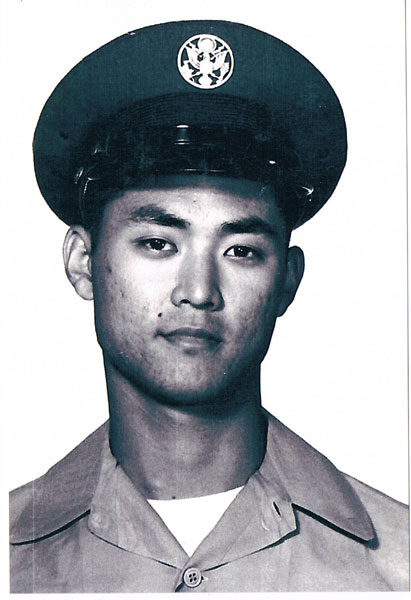
(picture 1) |
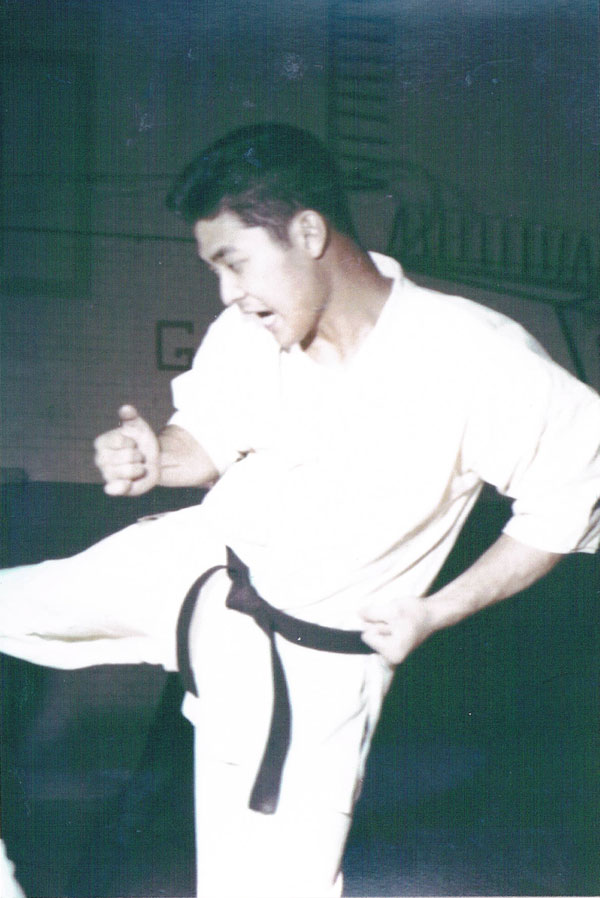
(Picture 2) |
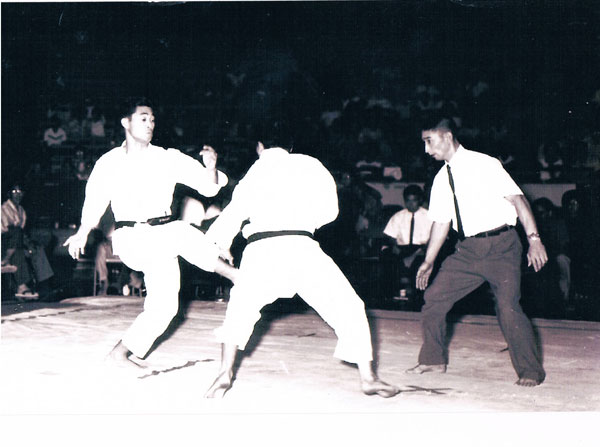
(picture 3) |
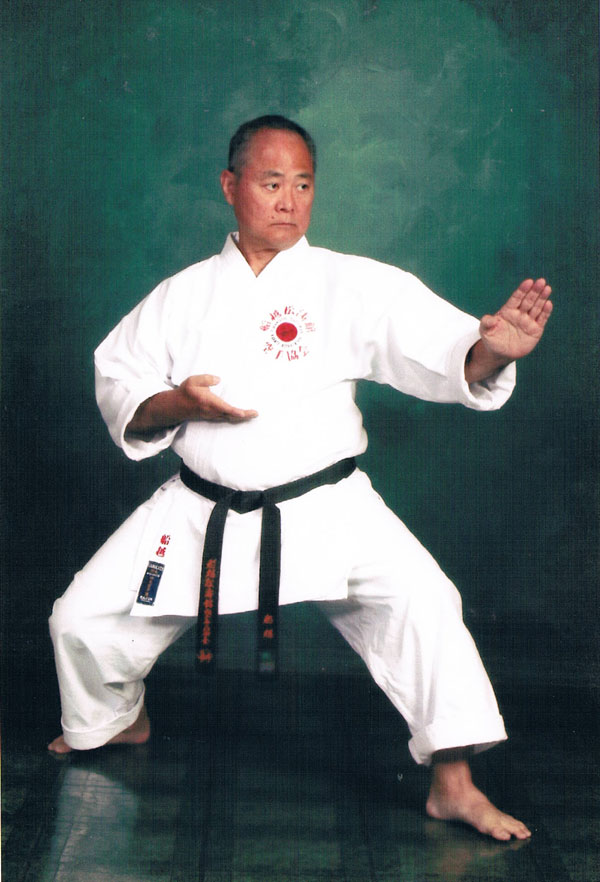
(picture 4) |

in Hawaii |
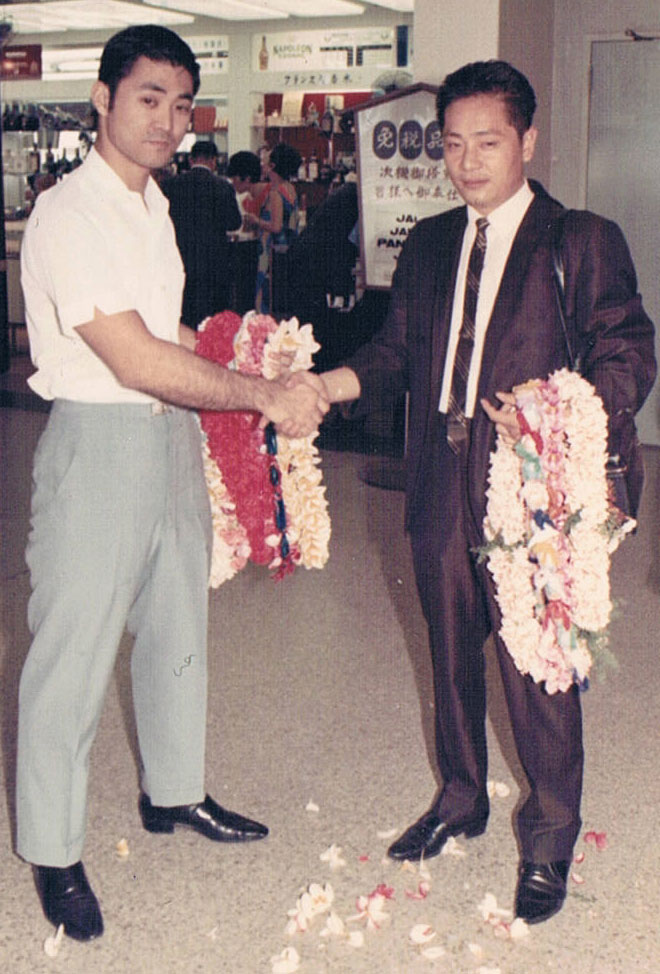
in Hawaii |
Mr. Charles Lee
June 3rd, 2007 Interview at Master Asai Memorial Camp in Hawaii
I started training karate when I was 19 years old as university student. After I had my first job, I stopped, stopped for six years. Then in 1983, I decided to come back - It was also a year that my youngest son was born, and so it was just like a sign because that was the first year I decided to come back and also trained with Asai Sensei. It’s been 23 years.
Every morning at five o’clock, I’d train with Asai Sensei. Those … improved my karate so much. When he finishes his training, he would work with us and train us on kata and kumite for another hour to hour and a half. He gave his time for us. Before I met Asai Sensei, my karate was just average, if not mediocre and I learned so much from Asai Sensei. He’s passed away and future generations won’t get to know him or meet him so I keep talking about him to my students.
I learned so much from him, but most of all, what I learned from him was how to generate power through relaxation, by watching him and by being with him. I gained so much from him so I try to give that to my students also. His personality was always so giving. He was always willing to teach, and that is also what I want to give to my students, and what I miss about Asai Sensei. So the last five years I wanted to train with him as much I as I could - may it be in Hawaii, or by going to wherever he was at to train with him, like the time in New Zealand. In 2000, Sensei was in Hungry so I went there to train with him. In 2001 and 2002, I went with him and joined the summer camp in Switzerland. In 2003, I founded a big dojo in New Zealand, and I am happy that I was able to found a dojo there, and it was my biggest thrill and a great experience having Asai Sensei giving seminars there - but most of all, I was able to introduce Asai Sensei to New Zealand.

|
|
| Mr. Charles Lee with Asai Family |
Mr. Walter Chihara
■2007.6.3 Master Asai Memorial Event in HAWAI
I think the total continuous training of karate is 26 years.
I have many many very fond memories of him. He is such a special man - so much beyond the technical aspect of karatedo: the spiritual way, his aproach, the humility, and the kindness... I always felt so comfortable around him. When we came to Japan when my daughter was a baby and you took us around and he made sure that we were always taken care of. Everytime I saw him when I came brought my students to Hokaiido for All Japan Tournament he always stopped and say hello to me. Every time I saw him I had the same feeling of warmth. So I will always hold a respect for him that way.
When he passed away I had lined up my seniors and I said that we should carry on his spirit of humility. Of course he was one of the most technicaly advanced martial artists the world will ever know. I think by the fact that he wanted us to learn the Junro kata’s, that was always important to him this past ten years or so. Junro kata combine all the different technical aspects of many styles of karate.
Asai sensei helped me to truly believe that it is a way of life to make the world a better place. Asai sensei always said “step-by-step.” It would be the best way to progress in life. Can’t try to go too fast, don’t try to do too much. Just step-by-step, I remember.
(An excerpt from the interview)
Mr. Lin Maw Tsu
■January, 2007
The 12 apprentices of Karatedo Domon Kyoudai Kai (“Association of brothers under common master”): Spring, Summer, Autumn, Winter (four seasons,) Loyalty, Piety, Altruism, Love, Trust, Nobility, Harmony, and Peace (the eight moral principles) came together in 1980, one brother did not show up for a long time. The other brothers started complaining and criticizing the brother for being late. Watching this, Asai Sensei told them: ”Your karate brotherhood is supposed to be stronger than the ties to your real family. When you behave like this, where is the duty to your brotherhood?” (*Chinese character for adopted brother, the ‘karate brother’ in this case, is ‘dutiful brother.’) His word stuck with me since then. When we found out later that this brother had some financial issues we got together and resolved the problem.
According to the Chinese martial arts ranking system, the “initiation” is when a beginner joins a dojo, and after 3 to 5 years of practice, the person can then practice in the hall of his master, reaching the stage called “toudou.” Over 10 years of practice from then, the next stage is called “Nyushistu,” which means “to enter the room”. The apprentice can now enter the room of his master and receive the order directly. It then takes from 30 years to a lifetime to be conferred a full master.
■September 25, 2007 At IJKA Taipei Main Dojo in Taiwan
What I remember of Asai Sensei is what he said when I asked him why he didn’t
perform Nihontou tori (Japanese sword taking with hands) at a demonstration.
He said that would be disrespectful to the masters of kendo. I think this is the ultimate form of butoku, the ethics of martial arts.
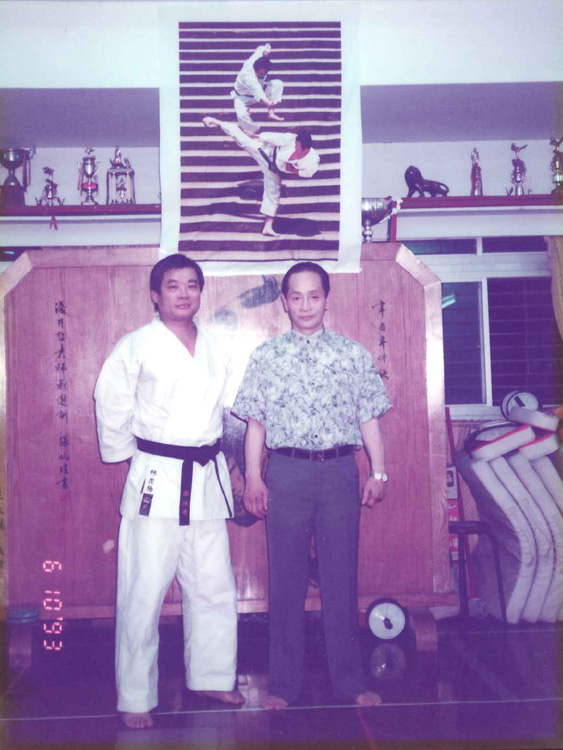
Picture: Mr. Lin Maw Tsu and late Master Asai
Mr. So Chi Shing
■January, 2007
Karatedo is my life. The first karatedo practice I joined in 1969 was instructed by Asai Sensei. The class room was packed with students; we could not even stretch our arms out. Years later, I became head chief of the Safety Department of a factory, a job I was able to acquire because of my karate skills. I met my wife there too. In 1979, I left the factory and opened a karatedo hall and became a fulltime instructor and I am still teaching.
Asai Sensei taught me a very important lesson with regards to karate practice: “To practice karate, one is to practice steadily, without stopping, and put every effort into training - and one must make time to think hard about each technique.”
I think it applies not only to karate, but also how one should be as a person. This concept has supported me throughout my karatedo career and my life, and had an enormous impact on me.
Whenever I reminisce about Asai Sensei, I am full of memories about him. My life is devoted to karate, and it will never change. But nobody will be able to copy Asai Sensei’s karate - we can watch, but not copy. This is because his karate reached the point where it was art.
Asai Sensei always talked about going into deep mountains and train, but could not make the time, as he was dedicated to teaching karate around the world. In Asai Sensei’s place, for six years now (11 years as of 2012) I have been going into deep mountains to do “Chi karate” training six hours a day to carry on the teachings of Asai Sensei.
We must not only reminisce about Asai Sensei, but also abide by his wishes and devote ourselves to karatedo.
■September 25, 2007 At IJKA Taipei Main Dojo in Taiwan
Karate was Asai Sensei’s life. He researched and explored karatedo his whole life.
He studied Chinese martial arts and incorporated it into karate and then introduced techniques of karate back to Chinese martial arts.
He advanced his skills continuously, and further improving them by training and training - which later on culminated as what we know of Asai Karate today. He devoted his life to continuous practice and advancement of himself. This is the reason why he was able to achieve so much.
We need to follow Asai sensei’s path and devote ourselves to training, and not only do this as his apprentice but also so that we can try to surpass him.
I have been doing karate for 39 years, since 1969 (43 years as of 2012.) My son started karate when he was 6 years old - he has been training for 23 years (28 years as of 2012.)
Mr. Wang Ju-Yu
■September 25, 2007 At IJKA Taipei Main Dojo in Taiwan
I have been practicing karate for 20 years (25 years as of 2012.)
I have 5 dan in Taiwan and international 3 dan (international 5 dan as of 2011)
Mr. Chou, Chih-Wen
■September 25, 2007 At IJKA Taipei Main Dojo in Taiwan
I have been practicing karate for 24 years (29 years as of 2012.)
introduce the talk with Tatsumi Sato Sensei,Jiro Katsuno Sensei,and Hiromi Miura Sensei
■2007.10.7 in Chiba,Sogacity
| Mr. Sato: |
When I accompanied Sensei to Brazil he asked me if I used body lotion in the bath, and he insisted I use one saying that I should start when I was still young. So I still use body lotion - feel my skin how smooth it is - I am using 3700 Yen lotion following his recommendation. I talk about Sensei all the time. I had a great time with him. I’ve just remembered the time when I asked him about his skin but I have so many fun stories and memories about him. I had known him for a long time. |
| Mr. katsuno: |
When we ate breakfast at a hotel he would devour bread and put his dirty Plates in front in front of me. He would grad a new plate so it would look like I ate all that food .And he would repeat the same thing and the dirty plates n front of me would get bigger and digger. |
| Mr. miura: |
When we ate meat he would take all the good part and give us the scraps.
That was something!.
|
| Mr. Sato: |
I am sure he had a fun time doing that to us. Then he would tease Katsuno-kun accusing him of eating the best parts. Katsuno-kun being so honest he would push the plates back and say ‘Sensei, no I didn’t!’The way Sensei ate was impressive. It is still a wonder where all that food went in that body. He didn’t have a stomach like myself and he was always slendar. |
| Mrs. Asai: |
There was no fat on him. |
| Mr. miura: |
Despite the amount of food he ate. |
| Mrs. Asai: | Having his scraps was still ok, but he used to say in front of people:‘Wow you eat so much. I can’t do that.’ |
| All : | That’s right. |
| Mrs. Asai: | Did he do the same to you? |
| All : | Yes. |
| Mr. Sato: | He was a great teacher. A very tough karate sensei. |
| All : | When it Came to Karate he was very strict. |
| Mr. katsuno: |
Before a competition there was a demonstration and I was called to help with Sensei’s demonstration, and was told to do gedan uke (lower block)and do a few punches. I didn’t get to practice with Sensei too often so I was really nervous but after a few punches he said, ‘ok, ok, that’s enough. If I fight back, your arm will get broken.’ I was so excited to practice with him so ‘ was taken aback by this. He Just said if I tried to be on the offense I would end up breaking my arm’ |
| Mr. miura: | He was amazingly fast.Just one snap could break people’s arms. His arm was a whip. |
| Mr. miura: | The way he recoiled his arm was so fast and so amazing. |
| Mr. Sato: | It was a whip. A whip. |
| Mr. katsuta: | That was really unbelievable. |
| Mr. miura: | There is no one like Sensei. I still tell my students about him for their education. If you get stared at by those eyes you would have the chills and be unable to move. That was really something. I still can’t get rid of the image of his eyes fixated on me. His eyes were powerful like no other. |
Mr. Vincenzo Serao
2011年9月


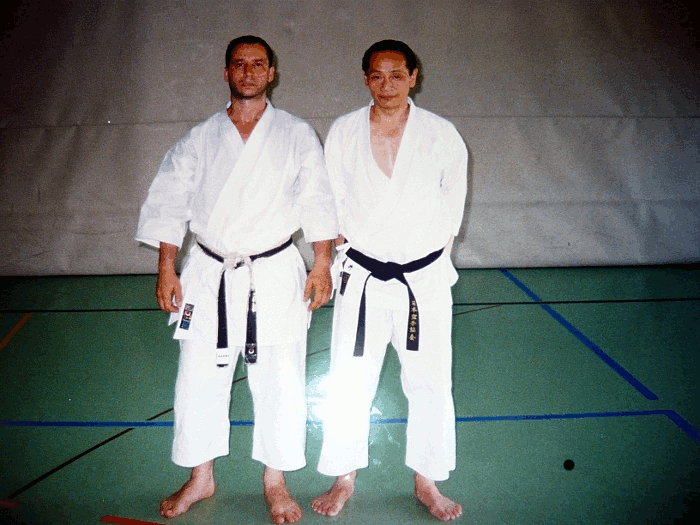
Dears Mrs KEIKO ASAI, J have to thank you for the kindness of your compliments towards us. You can use the letter and the pictures as you want. For us, it is a privilege to find space on your website IJKA ASAI!
Warm greetings
Vincenzo Serao
Hayabusakan Napoli
ITALIA
Dear Mrs Keiko Asai, it has been a huge pleasure to hear that my letter has been much liked by you and this fills with joy both j and all my friends. For us everybody it was a duty to show our gratefullness for all that Asai Sensei has given us with his teaching and we will keep on trasmetting with enthusiasm and all our strenghts. J hope heartily to be able to meet it possible to show as soon as possible from neighbour all my estimate and that of my friends than with me spent memorable moments with our darling Asai Sensei Shuseki Shihan. With estimate best regards
Vincenzo Serao
P.S. Even J pretty good writing English! J am sending some pictures for me recognize.
Naples, September 10 th 2011
Dear Mrs. KEIKO ASAI
it is a great honour for me and all of my friends from Naples to write this letter, hoping it has a meaning for you. My name is Vincenzo Serao, I live in Italy, in Naples and great has been the privilege to learn the teachings of our beloved Asai Sensei, Shuseki Shihan for several years, since 1993.
In 1988 we had decided to come to Japan, to Tokyo, near the Hombu Dojo to personally meet Asai Sensei, at that time become the leader of the old JKA after Nakayama Sensei’s death. His fame was already great and I perceived that in Him there was something different, special and that, despite what the others did, he went over the conventional limits. He was really Unique! I couldn’t manage to get to Japan, but two dear friends of mine reached Tokyo in February 1988. They were welcomed by Asai Sensei with great hospitality and for 40 days they stayed in the Hombu Dojo, becoming more and more confidential friends with Him. When they came back, they gave me as a gift a book with dedication signed by Asai Shihan that I jealously preserve together with so many other things I had from Him in all these years and most of all the DOJO KUN, personally written by Him.
Two years passed and to our great and glad surprise, we directly received from Asai the invitation to participate in the World Championship in Dubai, in the Arabic Emirates. For us it was above all the occasion of a wonderful adventure we would never dream could come true, and what’s more for free! In that occasion I finally had the honor to personally meet our beloved Sensei and everything I had thought about Him exceeded anything I had previously imagined.
Subsequently, after a few years and precisely for the first time for us in 1993, thanks to the dear and good Bruno Koller, who is really worthy, first of all for have given us the possibility to meet Asai Shuseki Shihan in the near Switzerland, all of us have had the fortune to be able to profit some teachings of the Teacher, the qual thing is repeated for many years up to the fatal event. I have to say that every time that we met there it was a great surprise; in fact, as soon as it perceived one of our group it drew near and with the finger it pointed out how much we were and every time that one of us presented Asai Sensei it smiled happy the hand bringing himself to the forehead. It was his way to give us a pleasant welcome. I still remember when in 2004, during a seminar in Switzerland, we went to do it visits him in his room in the hotel three dear friends of mine and I where Asai Sensei, together with a Japanese student that had just come from England, he was waiting us. Brought him a gift for her Mrs. Keiko Asai and him in joky tone said that the gifts had to do only them to Him, then started laughing!
In that occasion we spoke of as things, among which the great project that had in mind for his organization and of the great championship of the world that intended to realize in Taiwan. Then he asked us if we went to make shopping together with Him, because it had to purchase some gifts for his wife and I can say only that in that occasion we bathed there as fishes so it rained. In Switzerland it always rains, especially in summer! Who knows because? However been worth to go out with the our dear Sensei. What an honour for us!
Sees Mrs. Asai, I could write so many things but that to which I hold a lot to make to know to you and who will read this letter it is that we of the Neapolitan group, that has followed for so many years Asai Sensei, have independently done him with discretion and humility to be tied up or less to any organization or for anybody else interest. I confirm that what pushed us to follow the affectionate bond it was him and of great trust and respect in his dowries is technical, to which nobody can ever draw near and not even to imitate, but above all his humanity and the relationship that he knew how to establish with whoever it respected him. Asai Sensei has never asked us to what organization we belonged neither what pits our degree. I know only that during his seminars, at the end of the daily lesson, it was usual to hold a private lesson for little people and He always wanted that us Neapolitan we were present and you participate in his lessons. We in Naples am not many the true apprentices of the martial art, since the sporting Karate has had some the upper hand, as after all in Italy, but I can assure that we of our group will always follow the teachings traced by our Shuseki Shihan Asai Sensei and for the whole life we will keep on practising and to divulge the ASAI-RYU. I Wish its Organization and you, the IJKA ASAI a marvellous future that can spread all over the world really, as it was the desire of the dear Asai.
Hoping to meet you as soon as possible, sincerely yours
Vincenzo Serao
HAYABUSAKAN NAPOLI
ITALY
Radio Program「ああ我が人生空手道」
Also, we are going to start a new radio program hosted by I.J.K.A.. The show is called “My Life: Karate Journey,” and it will introduce not only Tetsuhiko Asai’s karate life, but also those people who shared a karate life with him. Currently we are looking for more materials to make the show more realistic and robust. If you have:
- Your personal experiences about Tetsuhiko Asai
- Anything related to Asai Sensei’s karate (advice, thoughts, actual lessons etc.)
- Videos and photos
We will air the stories on our radio show, with a mention of your karate-dojo and/or your name. This is to commemorate and celebrate Asai Shihan and his love for karate, so the karate styles or organizations do not matter. Tetsuhiko Asai’s biography movie about his karate filled life is in the production plan. The making of this radio show will be an important part of this movie.
If you have any questions please contact us at info@ijka.jp. Thank you again for your support and understanding. I look forward to hearing from you very soon.
